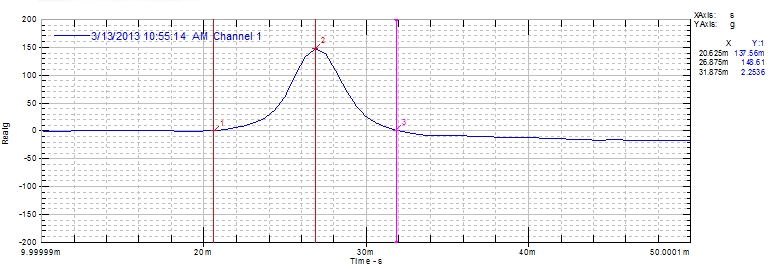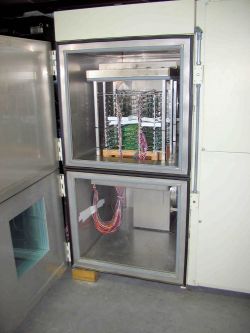IEC 60068-2 is a globally recognized standard that outlines a series of tests for products, components, and equipment to assess their ability to withstand environmental conditions. By simulating the different climatic conditions and mechanical stresses a product can undergo during its lifetime, environmental testing can help manufacturers validate the ruggedness, durability, and performance of their products.
One of the key tests within this series is the shock test, which is designed to simulate the effects of sudden impacts or abrupt changes in motion that a product might encounter during its lifecycle. Specifically, the International Electrotechnical Commission (IEC) manages two well-known shock and drop-shock standards for electrical and electronic-related technologies, IEC 60068-2-27 and IEC 60068-2-31.
- IEC 60068-2-27 Environmental testing Part 2-27: Test Ea: Shock
- IEC 60068-2-31 Environmental testing Part 2-31: Test Ec: Rough Handling Shocks
IEC 60068-2 shock testing is a critical part of product development for several reasons:
- Real-world conditions simulation: Products often encounter shocks and impacts during shipping, handling, and everyday use. IEC 60068-2 shock testing simulates these conditions to assess how well the product can withstand them.
- Identification of potential weaknesses: Shock testing can reveal design or manufacturing flaws that might cause the product to fail prematurely. Identifying these issues early in the development process can save time and money on product recalls or redesigns.
- Ensuring product reliability: For products that are used in critical applications, such as medical devices or aerospace components, shock testing is crucial to ensure they can perform reliably under all conditions.
- Worldwide recognition: IEC 60068-2 is an international standard, so products tested to this standard are accepted worldwide. This can simplify the process of selling your product in international markets.
At DES, we understand the importance of detailed and accurate shock testing. Our experienced team can guide you through the process, ensuring your product meets all relevant standards and is ready for the rigors of real-world use.
IEC 60068-2-27: A Detailed Look at the Shock Testing Standard
IEC 60068-2-27 is a specific test within the IEC 60068-2 series that focuses on shock testing. This test is designed to simulate the shock conditions that products, components, and equipment may encounter during transportation, storage, handling, or in use. The purpose of this test is to reveal mechanical deficiencies, degradation, and/or accumulate damage caused by shocks.
The IEC 60068-2-27 test is a crucial part of the product development process. It provides manufacturers with valuable insights into the potential weaknesses of their products, allowing them to make necessary improvements to enhance product durability.
The test involves subjecting the product to specified levels of shock impulses in a controlled environment. There are 3 types of shocks in IEC 60068-2-27, half-sine impulse, saw-tooth impulse, and the trapezoidal impulse. Much of this standard defines the pulse shapes and control of the shock parameters. Other sections cover the test severities such as the peak acceleration level, duration, and number of shocks. The user specifies which test severities are applicable to their products. Annex A provides guidance and examples of test severities for various applications. Annex B gives information about shock response spectra (SRS) and the characteristics of the pulse shapes. The product’s performance may be evaluated during the shocks or just before/after the test.
At Delserro Engineering Solutions, we have extensive experience conducting IEC 60068-2-27 shock testing. Our meticulous approach to testing ensures that your product is thoroughly evaluated for potential weaknesses, providing you with the information you need to make informed decisions about product improvements. Our commitment to quality and accuracy ensures that our testing procedures meet the highest standards of reliability and precision.
IEC 60068-2-31: Shocks Intended to Simulate Rough Handling
IEC60068-2-31 is another critical standard within the IEC 60068-2 series, focusing on simulating the effects of rough handling shocks. Rough handling shocks are knocks, jolts, and falls typically encountered during repair work, rough handling or dropping. IEC 60068-2-31 defines 3 types of rough handling shock tests:
- Drop and Topple is intended to assess the effects of knocks or jolts typically occurring during repair work or rough handling on a table or work-bench. The drop tests are accomplished by raising an edge or corner of an item to a prescribed height, then releasing it allowing the face under test to drop onto a hard surface. The topple test is performed by raising an edge slowly until instability occurs, then allowing the specimen to topple over onto an adjacent face. The number of drops or topples is usually 4.
- Free Fall – Procedure 1 is aimed at evaluating the effects of falls from rough handling. The entire specimen is raised to a defined height, then released allowing it to free fall onto a hard surface. The product can be oriented to allow the impact to occur on a face, edge or corner. Typically the number of free falls is 2.
- Free Fall – Procedure 2 is intended to reproduce repetitive shock conditions likely to occur on component-type specimens such as electrical connectors. The test specimens are subjected to a prescribed number of falls from a specified height onto a hard surface. The number of falls in procedure 2 typically ranges from 50 to 1,000.
At Delserro Engineering Solutions, we use a thorough approach when conducting IEC 60068-2-27 and IEC 60068-2-31 shock testing, ensuring that the test is performed under repeatable conditions and your product is evaluated for rugged usage.
Our testing process begins with a thorough understanding of your product and its intended use. This allows us to assess the shocks and impacts your product is likely to encounter. We then subject your product to a specified level of shocks or impacts in a controlled environment. This test can reveal defects in the product’s design or construction that might not be evident.
Throughout the testing process, our team of experts will keep you informed of our findings and will deliver a detailed report upon test completion. Our goal is to help you improve your product’s reliability and durability, ultimately enhancing its market success.
Our commitment to quality and accuracy is demonstrated by our compliance with ISO/IEC 17025, a globally recognized standard for testing and calibration laboratories. Furthermore, our lab is accredited by A2LA, the country’s leading accreditation agency. This ensures that all tests conducted are technically competent, reliable, and of the highest quality. Clients can have peace of mind knowing that their products are tested with precision and accuracy, minimizing the risk of product failures in the market.
IEC 60068 2: Why Choose DES for Your Shock Testing Needs
Choosing the right partner for your shock testing needs is crucial. At Delserro Engineering Solutions, we offer a comprehensive suite of services designed to ensure your products meet the stringent IEC 60068-2 standards. Here’s why DES should be your first choice:
- Experience: With over 30 years in the industry, we have the expertise to conduct thorough and accurate shock testing for a wide range of products. Our team has managed testing projects for clients all over the world, including renowned organizations like Adidas, Crayola, Medtronic, Rolls Royce, Boeing, Lockheed Martin, NASA and the U.S. Army.
- Quality Assurance: Our lab is ISO/IEC 17025 compliant and A2LA accredited, ensuring the highest level of quality and reliability in our testing procedures. This commitment to quality is demonstrated in every test we conduct, providing you with confidence that your product has been thoroughly evaluated and meets all relevant standards.
- Customized Solutions: We understand that every product is unique, so we tailor our testing methods to meet your specific needs. Our team works closely with you to understand your product and its intended use, allowing us to customize our testing process to accurately simulates the shocks and impacts your product is likely to encounter.
- Client Satisfaction: We’ve worked with global clients and have received positive feedback on our seamless procedures, high level of service, and impressive test results. Our commitment to client satisfaction is evident in every project we undertake, and we strive to exceed your expectations at every turn.
Contact DES today to discuss your IEC 60068-2 shock testing requirements with one of our experts. We’re here to help you ensure your product’s success in the market.


